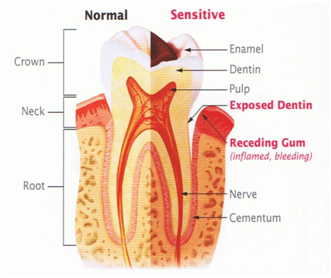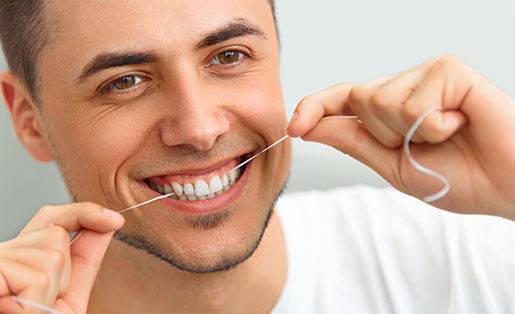Signs of Sensitive Teeth
Tooth sensitivity is the feeling of discomfort or pain when teeth are exposed to hot or cold temperatures. Sensitivity can also occur while flossing and brushing teeth, consuming acidic foods, eating/chewing and/or breathing in cold air.
Reasons For Teeth Sensitivity
In healthy teeth, a layer of enamel protects the crown of the tooth: area above your gums. Under the gum line a layer called cementum protects the roots. Under both the enamel and cementum is a layer called dentine.
Dentine is less dense than enamel and cementum and contains microscopic tubules When dentin loses its protective covering of enamel or cementum these tubules allow heat and cold or acidic or sticky foods to reach the nerves and cells inside the tooth. Dentin may also be exposed when gums recede. The result can be hypersensitivity.
Possible Causes of Sensitive Teeth
Teeth sensitivity can be caused due to:
- Worn tooth enamel: High intake of acidic foods, over brushing, genetic enamel deficiencies.
- Exposed tooth root: Over brushing, grinding/clenching teeth which leads to gum recession.
- Gum disease
- Tooth decay or worn fillings.
- Fractured teeth.
Sensitive teeth can be treated depending on the causes of sensitivity which can be determined by a dental health professional.

Flossing along with brushing!!
One question you are almost always guaranteed to be asked by a dental professional is “Have you been flossing?”
Often you may think that why is flossing necessary when you are brushing twice a day?
While brushing twice a day will help you with maintaining your oral health, you are not getting an optimal clean unless you floss your teeth.
Here is why…
A toothbrush works by physically removing plaque – a layer of sticky bacteria from your teeth. Fluoride from your toothpaste will help reduce the bacteria in your mouth. Unfortunately the toothbrush bristles are too large to reach between the teeth.
Floss is very beneficial in disturbing and removing biofilm of plaque from between the teeth and below the gums. The Australian Dental Association suggests flossing before you brush to make brushing more effective. After the biofilm has been disturbed from between the teeth then toothpaste with fluoride can get into more parts in your mouth.
If teeth are not flossed they can cause cavitations between the teeth and also lead to periodontal gum disease.

Written by
Oral Health Therapist and Hygienist – Malavika
Complementing the fantastic efforts of Alana (OHT)


